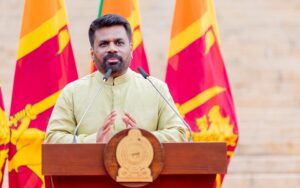
Sri Lanka’s Economy Balancing Recovery and Risk Amid Reforms and Global Pressures
- CNL Reporter
- June 29, 2025
- Weekly Economic Review
- Sri Lanka’s Economy
- 0 Comments
Weekly Economic Review
Sri Lanka’s economy, at the close of June 2025, presents a complex picture of cautious optimism amid persistent structural and external challenges. As the country continues its post-crisis recovery path, recent economic developments reflect both progress in stabilization and the mounting pressure to implement long-overdue reforms.
Moderate Growth amid Lingering Vulnerabilities
The Sri Lankan economy, having begun its turnaround in mid-2023 after suffering its worst economic crisis since independence in 2022, is showing moderate signs of resilience. The crisis, triggered by years of fiscal mismanagement, structural inefficiencies, and external shocks, resulted in a sovereign default and a near depletion of foreign reserves.
According to forecasts by international institutions, Sri Lanka’s gross domestic product (GDP) is expected to grow at 3.9% in 2025, with a further slowdown to 3.4% anticipated in 2026. While these projections confirm the trajectory of recovery, the pace remains subdued, underscoring the need for continued macroeconomic reforms and institutional restructuring.
Inflation Trends and Monetary Policy

Disinflation continued into May 2025, although certain price pressures are beginning to re-emerge. Headline inflation slowed to just 0.7% year-on-year, but food inflation accelerated to 5.2%, largely offsetting a 3.3% deflation in non-food items. The Colombo Consumer Price Index (CCPI) registered a 0.82% month-on-month increase, largely driven by rising food prices.
Core inflation, which excludes volatile food and energy items, rose to 1.2% in May from 0.8% in April—suggesting that underlying inflationary trends may be picking up. Analysts expect inflation to turn positive in the third quarter of 2025, moving toward the Central Bank’s target of 5%.
Against this backdrop, the Central Bank of Sri Lanka has maintained its accommodative monetary policy stance. Following rate cuts in 2024, the easing cycle continued into early 2025, supporting domestic economic activity while keeping inflation in check.
Exports Show Mixed Performance
Sri Lanka’s merchandise exports in May 2025 rose by 1.7% year-on-year to $1.03 billion, supported by gains in tea and coconut product exports. However, key sectors such as apparel and rubber recorded declines. Apparel exports dipped marginally by 0.38% to $388.8 million, while rubber-based exports contracted by 9.3% to $131 million. These two categories are heavily reliant on demand from the U.S. and U.K. markets—both of which showed declines this month. Exports to the U.S. fell 2.67% to $216.7 million, partly due to continued impacts from Trump-era tariffs, while shipments to the U.K. dropped 5.77% to $68.7 million.
In contrast, coconut-based exports surged 33% to $92.9 million, and tea exports grew 14.5% to $131 million. Cumulative merchandise exports for the first five months of 2025 rose 5.46% year-on-year to $5.34 billion, a promising sign of resilience despite global headwinds.

Meanwhile, services exports also recorded impressive growth, rising 22.3% year-on-year in May to reach $1.03 billion. Transport and logistics services led the surge, increasing 22.39% to $358.1 million. ICT/BPM services contributed $128.2 million, up 17.4%. However, the construction sector contracted by 4.6%, and financial services dropped significantly by 27.1% to just $5 million. Total services exports up to May stood at $1.59 billion, a 22% increase from the same period last year.
Fiscal Position and Structural Reforms
The government continues to make progress in revenue collection and fiscal consolidation. The primary surplus has improved, bolstered by higher VAT revenue and restrained spending. Yet, recurrent costs are on the rise, posing risks to long-term fiscal sustainability.
An “in-principle” agreement on debt restructuring has been reached with bilateral creditors, providing a temporary cushion for external obligations. However, Sri Lanka still faces the broader challenge of external debt sustainability and a looming current account deficit in 2025, compounded by a widening merchandise trade gap in 2024.
The World Bank and other development partners have reiterated the urgency of implementing structural reforms. These include enhancing tax administration, improving public financial management, ensuring debt transparency, and fostering an environment conducive to private investment and job creation.
A Critical Call for a New Economic Vision
One of the most thought-provoking economic commentaries of the week came from Verité Research Director Subhashini Abeysinghe, who issued a sharp critique of Sri Lanka’s long-standing failure to leverage its strategic location.

Speaking at the CA Sri Lanka Tax Symposium in Colombo, Abeysinghe contrasted the success of nations like Singapore, Hong Kong, and Taiwan with Sri Lanka’s protectionist and outdated economic model. “Hong Kong and Singapore realized they had only one thing—their location. They built their economies around making that work,” she stated.
In contrast, Sri Lanka continues to rely on industries like tea and apparel—legacy sectors from the 1980s and 1990s—while failing to adapt to global trends. “We are not thinking of what the world needs. If you want to produce for the global market, you need to constantly understand what the world demands,” Abeysinghe added, calling for a mindset shift toward innovation, competitiveness, and market-oriented strategies.
Tourism and External Sector Outlook
Tourism remains a bright spot in the economic landscape, playing a key role in supporting the current account and contributing to domestic demand. The revival in tourist arrivals is also helping boost foreign exchange reserves and reduce external financing gaps.

A potential upgrade in the country’s credit ratings could help lower borrowing costs and improve investor confidence. However, the economic outlook remains clouded by global uncertainties—including potential trade tensions, rising oil prices, and geopolitical developments—that could adversely affect Sri Lanka’s external sector.
Risks to Recovery and Political Uncertainty
While the IMF-backed Extended Fund Facility (EFF) continues to provide a framework for policy consistency and macroeconomic stabilization, the pace and direction of reforms could be affected by the political calendar. Delays in upcoming elections or increased political instability could derail reform momentum and undermine confidence.
Sri Lanka’s recovery has been notable but fragile. Deep-rooted structural bottlenecks continue to hinder sustainable growth. The country needs to pivot away from outdated economic strategies and toward a future that embraces innovation, global integration, and resilience.
Conclusion: Cautious Optimism with Reforms on the Horizon
As June ends, Sri Lanka stands at a critical economic juncture. Stabilization has been achieved in key areas—lower inflation, improved exports, and a stronger primary balance—but the road ahead requires disciplined policy implementation and a bold shift in economic strategy.
The country’s future depends not only on managing its macroeconomic fundamentals but also on changing the way it views its own potential. Unlocking growth will require forward-thinking leadership, institutional reform, and a fundamental realignment with global market demands.
The coming months will be crucial in determining whether Sri Lanka can transform its recovery into long-term, inclusive, and sustainable growth.




